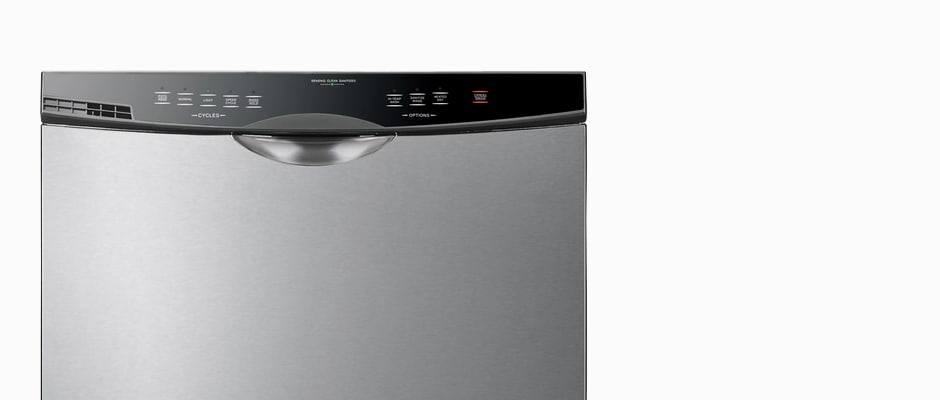Introduction
Design & Usability
{{section_header}}{{section.name}}{{/section_header}}
This {{product.name}} is designed so as to preclude confusion about buttons and gizmos, dagnabbit!
The design of the {{product.model}} is more about pragmatism than aesthetics. A shiny, black, flimsy-looking control panel sits above dull, dark stainless. The entire exterior completely omits the "Haier" name—an interesting branding decision, considering this is one of the first dishwashers the company has imported to the US. Read into that what you will.
Open the door and you'll find the wash tub interior is also covered in stainless steel—a design element that helps expedite the drying process in this case. Unfortunately, the lack of overall soundproofing means even a stainless interior doesn't do much to dampen the noise. This dishwasher is loud—not deafeningly loud, but it’s noisier than your average modern machine.
The bottom rack includes 10 rows of tines (10!), two of which can be collapsed to make more room for bulkier dishes. They are all evenly spaced and sensibly positioned, which certainly contributes to the machine’s high load capacity. While the four rows on the upper rack are less impressive when it comes to flexibility and capacity, we certainly didn’t have any problems. It's a standard layout, and we don’t imagine you’ll have any problems either. The cutlery holder felt a little cheap but it served its purpose, namely to hold silverware and utensils. It is also removable, to accomodate large, bulky dishes.
{{photo_gallery "Front Closed Photo", "Fingerprints Photo", "Controls 1 Photo", "Controls 2 Photo", "Front Open Photo", "Interior Detail Photo", "Top Rack Photo", "Top Rack Detail Photo 1", "Top Rack Detail Photo 2", "Top Rack Detail Photo 3", "Bottom Rack Photo", "Bottom Rack Detail Photo 2", "Bottom Rack Detail Photo 3", "Cutlery Basket Photo", "Cutlery Basket Detail Photo 1", "Cutlery Basket Detail Photo 2", "Cutlery Basket Detail Photo 3"}}
Features
{{section_header}}{{section.name}}{{/section_header}}
Nothing stands out and nothing is missing... except maybe a delay option.
The {{product.model}} includes four main washes, plus a Rinse & Hold cycle intended for prepping dishes for washing at a later time. The customization options are indistinguishable from the wash options, as they are all add-ons to individual cycles. They’re pretty run-of-the-mill: High-Temperature Wash, Sanitize Rinse, and Heated Dry. The only thing missing is a delay option, but for the price, it’s hard to complain. Aside from the rinse cycle and status display, that's all there is.
Since Haier is relatively new to the dishwasher game in the US, the DWL2825SDSS may be hard to find. It may also prove difficult to obtain parts locally.
Performance
{{section_header}}{{section.name}}{{/section_header}}
Overall wash performance was only frustrating in its inconsistency; most of the cycles were fairly quick to complete.
While some dishes in certain cycles—whether Speed, Normal, or Pots & Pans—came out shining and nearly perfect, others were downright filthy. Since we followed the manufacturer's instructions regarding dish loading, this indicates a spray pattern design flaw.
The Normal wash was probably the most inconsistent, but effective on the dishes that did come out clean. Conversely, the Speed Cycle was more consistent than anything else, but the worst cycle in terms of overall cleaning; we’d only recommend using it for very light wash loads.
Conclusion
{{section_header}}{{section.name}}{{/section_header}}
You get more than you pay for... though with such a low price tag, that's not necessarily saying much.
The {{product.model}}’s greatest feature may be its price. With an MSRP of $499 and sale prices that fall far below that, it offers a solid (albeit inconsistent) clean, decent efficiency, a stainless steel interior and exterior, high dish capacity, and enough wash options to satisfy most cleaning needs.
It should be noted, though, that none of the features are particularly impressive. You're getting a budget dishwasher, and it is what it is.
Science Introduction
{{section_header}}{{section.name}}{{/section_header}}
With decent, but inconsistent performance, the {{product.name}} is an acceptable option for homeowners looking to save some money on a plain-old dishwasher. Impressive performance is somewhat inconsistent; otherwise, it's a middle-of-the-road, budget option.
Performance
{{section_header}}{{section.name}}{{/section_header}}
Never the same results twice; a shame, since half the time it did really well.
Quick cycles usually fall short in a few specific stain tests (milk, spinach, egg), but the Speed Cycle was most notably inferior in our meat test. For the other tests, it actually did pretty well, though there was a drastic difference in the spinach test across multiple runs. Normal, the main workhorse cycle, nearly aced our dried milk stain test (in which we cook milk to the bottom of drinking glasses) the first time around, but the second time it was virtually ineffective. There was a similar disparity in our spinach, meat, and lipstick tests.
Given the performance of the other cycles, the Pots & Pans wash did surprisingly well on our baked lasagna test, but it was still somewhat inconsistent. Unfortunately, it was virtually useless on the burnt cheese stain. More impressive was its performance on our lipstick test, which is always the most difficult stain for machines to remove. It was also the longest cycle, clocking in at about 134 minutes. The others were considerably shorter: 34 minutes on the Speed Cycle, 54 on the Light, and 98 on Normal.
{{photo_gallery "Science Section 1 Images"}}
Efficiency
{{section_header}}{{section.name}}{{/section_header}}
Relatively efficient when it comes to power consumption, but not as much in regards to water use
While the Pots & Pans cycle used a substantial 1.01 kWh per wash (for a cost of roughly 10 cents), the Speed Cycle and Normal wash used 0.40 and 0.69 kWh, respectively. However, we imagine that much of this efficiency is the result of the {{product.model}}’s relatively low wash temperatures, which only reached 139ºF in the Normal wash.
Where this machine starts to drop the ball is with its heavy water consumption. While the Speed Cycle, not surprisingly, required a mere 2.97 gallons of hot water, the Normal and Pots & Pans cycles consumed 7.22 and 8.67 gallons, respectively. We calculated that—between the Speed, Normal and Pots & Pans cycles—the {{product.model}} will cost about 8, 17, and 23 cents per wash. Based on the assumption that the Normal wash will be used 50 percent of the time, we expect the machine will cost you about $34 a year to operate; it's not really an above-average figure, but still far from the realm of “efficient.”
{{photo_gallery "Science Section 2 Images"}}
Capacity
{{section_header}}{{section.name}}{{/section_header}}
Above-average capacity for a below-average price
One of the {{product.model}}'s stand-out traits is its fairly high load capacity. We were able to fit 11 place settings in, including a serving setting, at one time. This is well above average and is likely a testament to the pragmatic, flexible design of the bottom rack.
{{photo_gallery "Science Section 3 Images"}}
Meet the tester
Tyler Wells Lynch is a freelance writer and journalist whose work has appeared in Vice, Wirecutter, Gizmodo, The Rumpus, Yes!, and the Huffington Post, among others. He lives in Maine.
Checking our work.
Our team is here for one purpose: to help you buy the best stuff and love what you own. Our writers, editors, and lab technicians obsess over the products we cover to make sure you're confident and satisfied. Have a different opinion about something we recommend? Email us and we'll compare notes.
Shoot us an email



